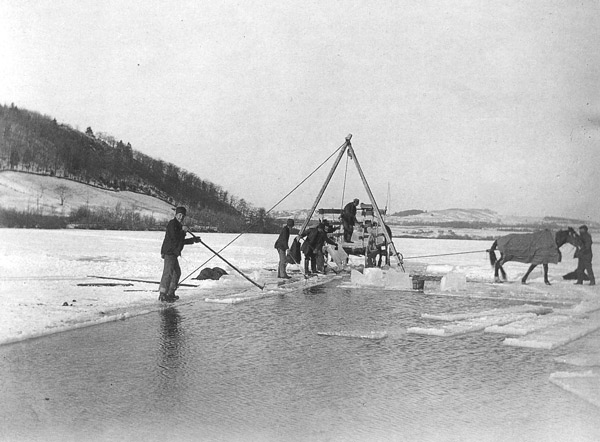B A C K T H E N
Winter Harvest

About 1900. Loading ice at the Rockland end of Chickawaukie (formerly Tolman’s pond, formally Chickawauka) Pond. The Rockland-Rockport line nearly divides the pond at a diagonal angle.
These men are probably farmers cutting ice for their own use. Chickawaukie was adjacent to a rich farming district of 2,000 acres of limestone soil (further enhanced by the convenient supply of lime ash) known as The Meadows, lying in a valley running southwesterly along the base of the Madambettox highlands. Along with vegetables and fruit production, the area was known for its large dairy farms and fine herds of Jersey cows—the local produce market extended to the quarry islands. A year-round supply of ice for refrigeration was essential for cooling milk, cream, and butter.
There was large-scale commercial ice cutting on Chickawaukie as well. In 1888, L.E. Marsh cut 4,000 tons, and maintained icehouses on the pond and on Tillson’s Wharf for the retail trade and for supplying fishing vessels. During the great speculative ice-cutting boom of 1890, 25,000 tons were cut and stored in houses hastily thrown up with the expectation of high prices in cities to the south the following summer. How much meltwater ended up running back into the pond when the boom collapsed is not known.
Local demand for ice increased in later years, reflecting growth in the fresh-fish business, lobster shipping, and also the summer cottage trade. Eventually there were three firms with large houses located on the pond, while the McLoons, big lobster dealers, filled a fourth house located in The Meadows. Ice was last cut commercially on Chickawaukie in the 1950s; there are no more dairy farms in The Meadows.
The bright afternoon sun suggests that the photo was taken late in the season, possibly after the commercial houses had been filled—only a small field has been scraped. The horses are considerately blanketed; the horse at right, hoisting the ice, is fitted with a looped “choker,” to be drawn tight should the animal fall in. A cinched choker kept the lungs inflated, quieted the horse’s struggles, and gave rescuers purchase. The hoisting shears are guyed to an anchor fastened in the ice.
Chickawaukie was conveniently located for ice harvesting in several respects. Due to very local climatic conditions, the pond often accumulated substantially less snow than did nearby ponds, and less scraping was required. Since at least the 1920s this attribute has endeared the pond to iceboaters. The pond’s ice was so clear that a newspaper headline could be read through a thirty-inch block. Beginning in 1852 the pond supplied drinking water to Rockland.
Retired Maine farmers invariably recall ice cutting with much nostalgia. Some just liked the work itself, while all enjoyed the wonderful camaraderie that accompanied this annual ritual of neighborly cooperation. Among the saddest side-effects of the drastic reduction in the number of Maine dairy farms has been the loss of a sense of community among farm people. Today’s surviving dairy farmers, isolated even in their own towns, often only hear from their neighbors after spreading manure.
Text by William H. Bunting from A Days Work, Part 1, A Sampler of Historic Maine Photographs, 1860–1920, Part II. Published by Tilbury House Publishers, 12 Starr St., Thomaston, Maine. 800-582-1899.
